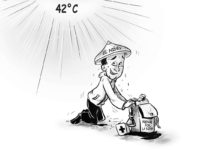[av_one_full first min_height=” vertical_alignment=” space=” custom_margin=” margin=’0px’ padding=’0px’ border=” border_color=” radius=’0px’ background_color=” src=” background_position=’top left’ background_repeat=’no-repeat’ animation=”]
[av_heading heading=’URBAN FARMER | Improve the quality and price of rubber cuplumps’ tag=’h3′ style=’blockquote modern-quote’ size=” subheading_active=’subheading_below’ subheading_size=’15’ padding=’10’ color=” custom_font=”]
BY JULIO P. YAP JR.
[/av_heading]
[av_textblock size=” font_color=” color=”]
Monday, May 22, 2017
[/av_textblock]
[av_textblock size=” font_color=” color=”]
THE DEVELOPMENT of a new sensor is expected to improve the quality of rubber cup lumps, which could be sold at a higher price.
The sensor will prevent rubber latex processors, farmers, and brokers from using battery solution in rubber latex coagulation.
The project to develop the gadget dubbed “Nanosensors for Rubber Quality Assessment” aims to utilize a method that can potentially differentiate a cuplump formed using formic acid or acetic acid from a cuplump formed by using sulfuric acid.
Nanosensors are chemical or mechanical sensors that can be used to detect the presence of chemical species and nanoparticles on the nanoscale.
The Philippine Council for Agriculture, Aquatic and Natural Resources Research and Development of the Department of Science and Technology (PCAARRD-DOST) and the De La Salle University (DLSU) are spearheading the project.
Cuplump is the coagulated material found in the rubber collection cup and is used to manufacture TSR10 and TSR20 grade rubbers, which are most widely used in the tyre and rubber industry.
The raw material obtained by processors from the farmers or traders is commonly in form of cup lumps.
Aside from the weak quality of rubber when processed, the use of battery solution poses negative effect to human health and the environment.
The prescribed coagulating agent is formic acid as it dispels water instead of absorbing it.
The nanosensors will serve as tool in rubber quality assessment and a technical support for the local government units (LGUs) to implement ordinances in penalizing anyone in possession of the regulated cup lumps.
Rubber regulatory agents will be then equipped with the gadget that can immediately determine if the cuplumps are coagulated with battery solution.
Some local government units ban the use of battery solution to thicken cup lumps.
This practice tends to absorb more water, resulting to heavier cuplumps when sold at the “bagsakan centers.”
The Forestry and Environment Research Division (FERD) of PCAARRD and the DLSU have initially conducted field testing of the nanosensors for rubber in at least two major rubber bagsakan centers – one in Zamboanga Sibugay, and another in Tampilisan, Zamboanga del Norte.
PCAARRD Evaluators Dr. Leila C. America, FERD officer-in-charge, and Dr. Marcelino U. Siladan, Industry Strategic S&T Program Manager for Rubber, conducted the field testing.
While Dr. Jose Isagani B. Janairo, DLSU Associate Professor, leads the project.
The Department of Agriculture has said that rubber is one of the most popular agro-industrial crops in the world, especially in Southeast Asia and South Asia.
In the country, rubber growers are predominantly smallholders.
There are about 24 primary processors in Mindanao. Most processors are situated in Cotabato and Zambaonga Sibugay with an estimated total capacity of at least 225 tons and 80 tons per day, respectively.
There are an estimated 38,000 families dependent on the commodity and are mostly smallholders.
These families are expected to benefit from the development of the sensor, which will eventually increase their profits, and improve the quality of cup lumps that they will be producing. (jaypeeyap@ymail.com/PN)
[/av_textblock]
[/av_one_full]



